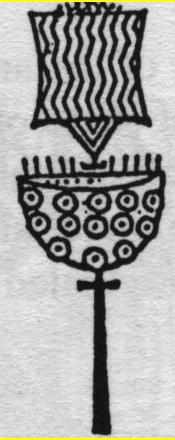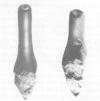Mirror: http://tinyurl.com/pghgfg8
A frequently occurring hieroglyph-multiplex on Indus Script Corpora is a 'standard device' generally in front of a one-horned young bull. The device is a hieroglyph-multiplex with components of lathe-gimlet, portable furnace, dotted circles (full of holes). These hieroglyph components are deciphered in the context of catalogus catalogorum of metalwork: trade caravan of seafaring merchants, sangar; kangar 'large portable furnace' and celebrations/trade announcements through trade processions. Nahal Mishmar standards show comparable orthographic features.
In a characteristic reduplication of words which is commonly noticed in the speech forms of Indian sprachbund (speech union or linguistic area), the standard device shown often in front of the one-horned young bull may be deciphered orthographically as: sãgaḍ kangar 'lathe, portable furnace'. Rebus deciphered renderings are: संगर sangar'trade sã̄goʻcaravanʼ'ghangar ghongor'full of holes' Rebus: kangar'large portable furnace, brazier'.
Taken on a procession, as depicted on two Mohenjo-daro tablets, the hieroglyph-multiplex is a declaration, an announcement of trade caravan with specialisation in lapidary-metal crafts described in the hieroglyphs carried on the procession by standard-bearers.
A vivid imagery of two Mohenjo-daro tablets is that of a standard device carried in a procession, evoking clear, unambiguous orthographic components: gimlet (drill-lathe), smoke emanating from furnace, (dotted circles) drilled beads: 1. sã̄goʻcaravanʼ of sang 'stone' workers and brazier-lapidaries engaged in sĕng'trading, trafficking (across the sea with foreign countries)' (Kashmiri); 2. kanga'large portable furnace'.The holes (dotted circles) as hieroglyph components: ghangar ghongor 'full of holes' (Santali) Rebus: kanga(r) 'large portable furnace' (Kashmiri)
The wavy lines shown on the drill bit are the artist-artisan's way of denoting the use of the drill using a bow-drill. The bottom part of the hieroglyph is a portable furnace with flames emerging from the surface and the bead drilled through after heating in the furnace coals or crucible.
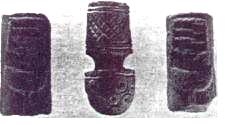 Carved ivory standard in the middle [From Richard H. Meadow and Jonathan Mark Kenoyer, Harappa Excavations 1993: the city wall and inscribed materials, in: South Asian Archaeology ; Fig. 40.11, p. 467. Harappa 1990 and 1993: representations of 'standard'; 40.11a: H90-1687/3103-1: faience token; 40.11bH93-2092/5029-1: carved ivory standard fragment (split in half, made on a lathe and was probably cylindrical in shape; note the incisions with a circle motif while a broken spot on the lower portion indicates where the stand shaft would have been (found in the area of the 'Mughal Sarai' located to the south of Mound E across the Old Lahore-Multan Road); 40.11c H93-2051/3808-2:faience token)
Carved ivory standard in the middle [From Richard H. Meadow and Jonathan Mark Kenoyer, Harappa Excavations 1993: the city wall and inscribed materials, in: South Asian Archaeology ; Fig. 40.11, p. 467. Harappa 1990 and 1993: representations of 'standard'; 40.11a: H90-1687/3103-1: faience token; 40.11bH93-2092/5029-1: carved ivory standard fragment (split in half, made on a lathe and was probably cylindrical in shape; note the incisions with a circle motif while a broken spot on the lower portion indicates where the stand shaft would have been (found in the area of the 'Mughal Sarai' located to the south of Mound E across the Old Lahore-Multan Road); 40.11c H93-2051/3808-2:faience token)![]() Phtanite drill-heads from the surface of MNSE area, Moenjodaro (Massimo Vidale, 1987, p. 147) Reconstruction of a drill based on analogical comparisons with the drills used nowadays at Nagara, Gujarat, India: Upper pivot in copper is centered with the drill-head and inserted into a coconut shell. Wooden haft is used with a bow-string to churn. The phtanite drill-head is secured in the haft-hole with a thin coiling thread. The tip of the drill's working end shows the characteristic feature of the shallow hemispherical depression: a 'dotted circle'. (After Vidale, M., 1987. Some aspects of lapidary craft at Moenjodaro in the light of the surface record of Moneer South east Area. In M. Jansen and G. Urban (eds.), Interim Reports, Vol. 2, 113-150. Aachen).
Phtanite drill-heads from the surface of MNSE area, Moenjodaro (Massimo Vidale, 1987, p. 147) Reconstruction of a drill based on analogical comparisons with the drills used nowadays at Nagara, Gujarat, India: Upper pivot in copper is centered with the drill-head and inserted into a coconut shell. Wooden haft is used with a bow-string to churn. The phtanite drill-head is secured in the haft-hole with a thin coiling thread. The tip of the drill's working end shows the characteristic feature of the shallow hemispherical depression: a 'dotted circle'. (After Vidale, M., 1987. Some aspects of lapidary craft at Moenjodaro in the light of the surface record of Moneer South east Area. In M. Jansen and G. Urban (eds.), Interim Reports, Vol. 2, 113-150. Aachen).
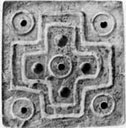 Mohenjo-daro Seal m0352 shows dotted circles in the four corners of a fire-altar and at the centre of the altar together with four raised 'bun' ingot-type rounded features.
Mohenjo-daro Seal m0352 shows dotted circles in the four corners of a fire-altar and at the centre of the altar together with four raised 'bun' ingot-type rounded features.S سنګر sangar, s.m. (2nd) A breastwork of stones, etc., erected to close a pass or road; lines, entrenchments. Pl. سنګرونه sangarūnah. See باره (Pashto) P باره bāraʿh, s.f. (3rd) A fortification, defence, rampart, a ditch, palisade, an entrenchment, a breastwork. Pl. يْ ey. See سنګر *saṁgaḍha ʻ collection of forts ʼ. [*gaḍha -- ]L. sãgaṛh m. ʻ line of entrenchments, stone walls for defence ʼ.(CDIAL 12845).*saṁghara ʻ living in the same house ʼ. [Cf. ságr̥ha<-> ĀpŚr. -- ghara -- ]Pa. saṅghara -- ʻ with one's own family (?) ʼ; L. sagghrā ʻ accompanied by one's own family ʼ; H. sã̄ghar m. ʻ wife's son by former husband ʼ.(CDIAL 12858).
karã̄ n. pl. ʻwristlets, banglesʼ(Gujarati)(CDIAL 2779)
Rebus khāra 'blacksmith': khāra-basta खार-बस््त । चर्मप्रसेविका f. the skin bellows of a blacksmith. -büṭhü -ब; । लोहकारभित्तिः f. the wall of a blacksmith's furnace or hearth. -bāy -बाय् । लोहकारपत्नी f. a blacksmith's wife (Gr.Gr. 34). -dŏkuru -द्वकुरु । लोहकारायोघनः m. a blacksmith's hammer, a sledge-hammer. -gȧji or -güjü -ग; । लोहकारचुल्लिः f. a blacksmith's furnace or hearth. -hāl -हाल् । लोहकारकन्दुः f. (sg. dat. -höjü -हा&above;जू&below; ), a blacksmith's smelting furnace; cf. hāl 5. -kūrü -कूरू; । लोहकारकन्या f. a blacksmith's daughter. -koṭu -क; । लोहकारपुत्रः m. the son of a blacksmith, esp. a skilful son, who can work at the same profession. -küṭü -क&above;टू&below; । लोहकारकन्या f. a blacksmith's daughter, esp. one who has the virtues and qualities properly belonging to her father's profession or caste. -më˘ʦü 1 -म्य&above;च; । लोहकारमृत्तिका f. (for 2, see [khāra 3] ), 'blacksmith's earth,' i.e. iron-ore. -nĕcyuwu -न्यचिव; । लोहकारात्मजः m. a blacksmith's son. -nay -नय् । लोहकारनालिका f. (for khāranay 2, see [khārun] ), the trough into which the blacksmith allows melted iron to flow after smelting. -ʦañĕ -च्&dotbelow;ञ । लोहकारशान्ताङ्गाराः f.pl. charcoal used by blacksmiths in their furnaces. -wān वान् । लोहकारापणः m. a blacksmith's shop, a forge, smithy (K.Pr. 3). -waṭh -वठ् । आघाताधारशिला m. (sg. dat. -waṭas -वटि ), the large stone used by a blacksmith as an anvil.(Kashmiri)
m0491 Tablet. Line drawing.This tablet showing four hieroglyphs may be called the Meluhha standard.Combined reading for the joined or ligatured glyphs is: dhatu kõdā sangaḍa ‘mineral, turner, stone-smithy guild’. Dawn of the bronze age is best exemplified by this Mohenjo-daro tablet which shows a procession of three hieroglyphs carried on the shoulders of three persons. The hieroglyphs are: 1. Scarf carried on a pole (dhatu 'scarf' Rebus: mineral ore); 2. A young bull carried on a stand kõdā Rebus: turner; 3. Portable standard device (Top part: lathe-gimlet; Bottom part: portable furnace sã̄gāḍ Rebus: stone-cutter sangatarāśū ). sanghāḍo (Gujarati) cutting stone, The fourth standard (illegible) may be a spoked-wheel as on Tukulti-Ninurta Fire altar. (eraka 'nave of wheel' Rebus:eraka 'moltencast copper'; arA 'spokes' Rebus: Ara 'brass'). Bottom part: portable furnace sã̄gāḍ Rebus: stone-cutter sangatarāśū ). sanghāḍo (Gujarati) cutting stone, gilding (Gujarati); sangsāru karaṇu = to stone (Sindhi) sanghāḍiyo, a worker on a lathe (Gujarati) sangataras. संगतराश lit. ‘to collect stones, stone-cutter, mason.’ संगतराश संज्ञा पुं० [फ़ा०] पत्थर काटने या गढ़नेवाला मजदूर । पत्थरकट । २. एक औजार जो पत्थर काटने के काम में आता है । (Dasa, Syamasundara. Hindi sabdasagara. Navina samskarana. 2nd ed. Kasi : Nagari Pracarini Sabha, 1965-1975.) पत्थर या लकडी पर नकाशी करनेवाला, संगतराश, ‘mason’.
The procession is a celebration of the graduation of a stone-cutter as a metal-turner in a smithy/forge. A sangatarāśū ‘stone-cutter’ or lapidary of neolithic/chalolithic age had graduated into a metal turner’s workshop (koḍ), working with metallic minerals (dhatu) of the bronze age.
This fourth standard could be compared with this hieroglyph of the Tukulti-Ninurta altar:
A spoked wheel is shown atop on the standard and the hieroglyph is also reinforced by depicting the hieroglyph on the top of the standard-bearer's head. This Meluhha hieroglyph is read rebus: eraka'knave of wheel' Rebus: 'moltencast copper'; āra 'spokes' Rebus: āra 'brass'.
Thus, the fourth profession is depicted as the smith working with metal alloys.
Hieroglyph: dhatu 'scarf' Rebus: dhatu 'mineral'
Hieroglyph: kõdā 'young bull calf' Rebus: kõdā 'turner-joiner' (forge), worker on a lathe
Hieroglyph: sã̄gāḍī 'lathe (gimlet), portable furnace' Rebus: sã̄gāḍī 'metalsmith associates (guild)'
Hieroglyph eraka āra 'knave of wheel', 'spokes of wheel' Rebus: eraka āra 'copper alloy brass'
Thus Rebus readings of the four hieroglyphs denote: ‘ mineral worker; metals turner-joiner (forge); worker on a lathe’ – associates (guild), copper alloy brass.
dhatu kõdā sã̄gāḍī eraka āra
The device has three hieroglyph-multiplex components: 1. lathe; 2. portable furnace; and 3. pierced holes (dotted circles).
sãghāṛɔ ʻlatheʼ; sãgaḍ 'lathe' (Gujarati.Marathi): saṁghāṭa m. ʻ fitting and joining of timber ʼ R. [√ghaṭ ]Pa. nāvā -- saṅghāṭa -- , dāru -- s° ʻ raft ʼ; Pk. saṁghāḍa -- , °ḍaga -- m., °ḍī -- f. ʻ pair ʼ; Ku. sĩgāṛ m. ʻ doorframe ʼ; N. saṅār, siṅhār ʻ threshold ʼ; Or. saṅghāṛi ʻ pair of fish roes, two rolls of thread for twisting into the sacred thread, quantity of fuel sufficient to maintain the cremation fire ʼ; Bi. sĩghārā ʻ triangular packet of betel ʼ; H. sĩghāṛā m. ʻ piece of cloth folded in triangular shape ʼ; G. sãghāṛɔ m. ʻ lathe ʼ; M. sãgaḍ f. ʻ a body formed of two or more fruits or animals or men &c. linked together, part of a turner's apparatus ʼ, m.f. ʻ float made of two canoes joined together ʼ (LM 417 compares saggarai at Limurike in the Periplus, Tam. śaṅgaḍam, Tu. jaṅgala ʻ double -- canoe ʼ), sã̄gāḍā m. ʻ frame of a building ʼ, °ḍī f. ʻ lathe ʼ; Si. san̆gaḷa ʻ pair ʼ,han̆guḷa, an̆g° ʻ double canoe, raft ʼ.Md. an̆goḷi ʻ junction ʼ?(CDIAL 12859) saṁghāṭayati ʻ joins together ʼ Sarvad., ʻ causes to collect ʼ Kathās. [√ghaṭ ]Or. saṅghāṛibā ʻ to mix up many materials, stir boiling curry, tie two cattle together and leave to graze ʼ. (CDIAL 12860).
aṅgāri f., aṅgāritā -- f. ʻ portable brazier ʼ lex. [áṅgāra -- ]H. ãgārī f.(CDIAL 130) aṅgāryāˊ -- , *aṅgāriyā -- , f. ʻ heap of embers ʼ. [Cf. aṅgā- rīya -- ʻ fit for making charcoal ʼ, aṅgārikā -- f., angāritā -- f. ʻ portable fireplace ʼ lex.: áṅgāra -- ]Wg. aṅarīˊk, aṅgríč ʻ charcoal ʼ; Paš. aṅgerík ʻ black charcoal ʼ, Shum. ãdotdot;gerík; Phal. aṅgerīˊ ʻ charcoal ʼ, aṅgerīˊṣi f. ʻ black charcoal ʼ; Ku. aṅāri ʻ sparks ʼ; G. ãgārī f. ʻ small hearth with embers in it ʼ.(CDIAL 131)
Stone: sang संग् संग्-दिल् संगि-खार or -khārah -खारह् (= संगि-मर््मर् संगि-फारस् a touch-stone of gems; a philosopher's stone (converting anything it touches into gold) (Śiv. 1616, 192; K.Pr. 184). -sār -सार् । अवहारः (सामुद्रिकजन्तुविशेषः ) m. stoning (to death), lapidation (H. viii, 8)(Kashmiri)
sāga-lar साग-लर् । कण्ठभूषाविशेषः f. a necklace composed of beads and pieces of glass or stone at intervals (El.; cf. sŏni-sāga-lar, s.v. sŏn 1). sang 2 संग् L. 65 gives a list of the most common local stones used for ornaments, and other purposes. These are (in his spelling) bilor, a white crystal; sang-i-baswatri, a yellow stone used in medicine; sang-i-dálam,used by goldsmiths; sang-i-farash (p. 64), a kind of slate; sang-i-Nadid, of a dark coffee colour; sang-i-Nalchan, a kind of soap-stone, from which cups and plates are made; sang-i-Musá, of a black colour;sang-i-Ratel, of a chocolate colour; sang-i-Shalamar, of a green colour; sang-i-sumák, coloured blue or purple, with green spots; Takht-i-Sulimán, coloured black, with white streaks. (Kashmiri)
Seafaring trade: sĕng स्यंग् । वाणिज्यम्, अलभ्यलाभः trading, trafficking (across the sea with foreign countries); met. the getting of something rare or unobtainable. -- zēnun ज़ेनुन् । वाणिज्यलाभः, दुर्लभेष्टाप्तिः m.inf. to conquer such trafficking, to make great profit by such trafficking; to obtain something rare and long desired. (Kashmiri)
संगर a [p= 1128,3] a bargain , transaction of sale L. (Monier-Williams)
saṅgarḥ संगरः 1 A promise, an agreement; तथेति तस्या वितथं प्रतीतः प्रत्यग्रहीत् संगरमग्रजन्मा R.5.26;11.48; पलितसंगराय 13.65. -2 Accepting, undertaking. -3 A bargain. saṅgata संगत Association, company. (Apte. Samskritam)Association of dotted circles and comb hieroglyph
 Ivory and bone objects, Harappa (After Vats, Pl.CXIX).No.6 is
Ivory and bone objects, Harappa (After Vats, Pl.CXIX).No.6 is an ivory comb fragment with one preserved tooth and ornamented with double incised circles (3.8 in. long). No.1 is another comb fragment, also with dotted circles. Nos. 13, 15, 16 are kohl sticks. Nos. 12, 17 to 29 are hair pins, needles and awls. Nos. 3-t, 30-41, 43 and 45-54 are balusters which could have been used as dice or for casting in any game of chance.

 Kalibangan, Ivory comb with three dotted circles; Kalibangan, Kalibangan, Ivory comb with three dotted circles; Kalibangan,Period II; Thapar 1979, Pl.XXVII, in: Ancient Cities of the Indus.  |
Black on red designs (radiant dotted circle) on cemetery pottery; Gamuwala Dahar and 13 other sites, Bahawalpur province, red fabric, red slip, black paint; Mughal, M.R., 1997, Pl. 60 and 61, Fig.17 Dotted circles and three lines on the obverse of many Failaka/Dilmun seals are read rebus as hieroglyphs: A (गोटा) gōṭā Spherical or spheroidal, pebble-form. (Marathi) Rebus: khoṭā ʻalloyedʼ (metal) (Marathi) खोट [khōṭa] f A mass of metal (unwrought or of old metal melted down); an ingot or wedge (Marathi). P. khoṭ m. ʻalloyʼ (CDIAL 3931) Dotted circles and three lines on the obverse of many Failaka/Dilmun seals are read rebus as hieroglyphs: A (गोटा) gōṭā Spherical or spheroidal, pebble-form. (Marathi) Rebus: khoṭā ʻalloyedʼ (metal) (Marathi) खोट [khōṭa] f A mass of metal (unwrought or of old metal melted down); an ingot or wedge (Marathi). P. khoṭ m. ʻalloyʼ (CDIAL 3931)kolom ‘three’ (Mu.) Rebus: kolami ‘furnace, smithy’ (Telugu) http://bharatkalyan97.blogspot.in/2013/06/indus-writing-on-dilmun-type-seals.html  Text 5477 Dotted circles + circumscribed fish + 'comb' motif. aya ‘fish’ (Mu.); rebus: aya ‘metal’ (Skt.) gaṇḍa set of four (Santali) kaṇḍa ‘fire-altar’ kanga 'comb' Rebus: kanga 'large portable brazier' ghangar ghongor 'full of holes' Rebus: kangar 'portable furnace'. Alternative 1: khareḍo = a currycomb (G.) Rebus: kharādī ‘ turner’ (G.) Alternative 2: Hindi kãgherā m. ʻ caste of comb -- makers ʼ, °rī f. ʻa woman of this casteʼ. kāmsako, kāmsiyo = a large sized comb (Gujarati); Rebus: kã̄sāri ʻpewterer’ (Bengali)  Ayo ‘fish’; kaṇḍa ‘arrow’ See: अयस्कांत [ ayaskānta ] m S (The iron gem.) The loadstone. (Molesworth. Marathi) Ayo ‘fish’; kaṇḍa ‘arrow’ See: अयस्कांत [ ayaskānta ] m S (The iron gem.) The loadstone. (Molesworth. Marathi)Fish + circumgraph of 4 (gaNDa) notches: ayaskāṇḍa ‘a quantity of iron, excellent iron’ (Pāṇ.gaṇ) The gloss kāṇḍa may also signify 'metal implements'. A cognate compound in Santali has: me~r.he~t khaNDa 'iron implements'. |
káṅkata m. ʻ comb ʼ AV., n. lex., °tī -- , °tikã -- f. lex. 2. *kaṅkaṭa -- 2 . 3. *kaṅkaśa -- . [Of doubtful IE. origin WP i 335, EWA i 137: aberrant -- uta -- as well as -- aśa -- replacing -- ata -- in MIA. and NIA.]1. Pk. kaṁkaya -- m. ʻ comb ʼ, kaṁkaya -- , °kaï -- m. ʻ name of a tree ʼ; Gy. eur. kangli f.; Wg. kuṇi -- přũ ʻ man's comb ʼ (for kuṇi -- cf. kuṇälík beside kuṅälík s.v. kr̥muka -- ; -- přũ seeprapavaṇa -- ); Bshk. kēṅg ʻ comb ʼ, Gaw. khēṅgīˊ, Sv. khḗṅgiā, Phal. khyḗṅgia, kēṅgī f., kāṅga ʻ combing ʼ in ṣiṣ k° dūm ʻ I comb my hair ʼ; Tor. kyäṅg ʻ comb ʼ (Dard. forms, esp. Gaw., Sv., Phal. but not Sh., prob. ← L. P. type < *kaṅgahiā -- , see 3 below); Sh. kōṅyi̯ f. (→ Ḍ. k*l ṅi f.), gil. (Lor.) kōĩ f. ʻ man's comb ʼ, kōũ m. ʻ woman's comb ʼ, pales. kōgō m. ʻ comb ʼ; K. kanguwu m. ʻ man's comb ʼ, kangañ f. ʻ woman's ʼ; WPah. bhad. kãˊke i ʻ a comb -- like fern ʼ, bhal. kãke i f. ʻ comb, plant with comb -- like leaves ʼ; N. kāṅiyo, kāĩyo ʻ comb ʼ, A. kã̄kai, B. kã̄kui; Or. kaṅkāi, kaṅkuāʻ comb ʼ, kakuā ʻ ladder -- like bier for carrying corpse to the burning -- ghat ʼ; Bi. kakwā ʻ comb ʼ, kaka hā, °hī, Mth. kakwā, Aw. lakh. kakawā, Bhoj. kakahī f.; H. kakaiyā ʻ shaped like a comb (of a brick) ʼ; G. (non -- Aryan tribes of Dharampur)
kākhāī f. ʻ comb ʼ; M. kaṅkvā m. ʻ comb ʼ, kã̄kaī f. ʻ a partic. shell fish and its shell ʼ; -- S. kaṅgu m. ʻ a partic. kind of small fish ʼ < *kaṅkuta -- ? -- Ext. with -- l -- in Ku. kã̄gilo, kāĩlo ʻ comb ʼ.2. G. (Soraṭh) kã̄gaṛ m. ʻ a weaver's instrument ʼ?3. L. kaṅghī f. ʻ comb, a fish of the perch family ʼ, awāṇ. kaghī ʻ comb ʼ; P. kaṅghā m. ʻ large comb ʼ, °ghī f. ʻ small comb for men, large one for women ʼ (→ H. kaṅghā m. ʻ man's comb ʼ,°gahī, °ghī f. ʻ woman's ʼ, kaṅghuā m. ʻ rake or harrow ʼ; Bi. kãga hī ʻ comb ʼ, Or. kaṅgei, M. kaṅgvā); -- .(CDIAL 2598) G. kã̄gsī f. ʻ comb ʼ, with metath. kã̄sko m., °kī f.; WPah. khaś. kāgśī, śeu. kāśkī ʻ a comblike fern ʼ or WPah.kṭg. kaṅgi f. ʻ comb ʼ; J. kāṅgṛu m. ʻ small comb ʼ.(CDIAL 2598) *kaṅkatakara ʻ comb -- maker ʼ. [káṅkata -- , kará -- 1 ]H. kãgherā m. ʻ caste of comb -- makers ʼ, °rī f. ʻ a woman of this caste ʼ.(CDIAL 2599) *kaṅkataśikha ʻ comb -- crested ʼ. [káṅkata -- , śíkhā -- ] WPah. khaś. kāgśī, śeu. kāśkī ʻ a comb -- like fern ʼ, or < *kaṅkaśa -- s.v. káṅkata -- (CDIAL 2600) कंकवा (p. 123) [ kaṅkavā ] m A sort of comb. See कंगवा .कंगवा [ kaṅgavā ] m A sort of comb. It has teeth but on one side and a curved back, and is mostly used to confine the शेंडी or वेणी , a horse-shoe-comb. (Marathi)
कोंगें (p. 180) [ kōṅgēṃ ] n A long sort of honeycomb. (Marathi)
ghangar ghongor 'full of holes' (Santali)
kāgni m. ʻ a small fire ʼ Vop. [ka -- 3 or kā -- , agní -- ] K. kang m. ʻ brazier, fireplace ʼ?(CDIAL 2999)
kangar 'large brazier': *kāṅgārikā ʻ poor or small brazier ʼ. [Cf. kāgni -- m. ʻ a small fire ʼ Vop.: ka -- 3 or kā -- , aṅgāri -- ]K. kã̄gürü , kã̄ga r f. ʻ portable brazier ʼ whence kangar m. ʻ large do. ʼ (or < *kāṅgāra -- ?); H. kã̄grī f. ʻ small portable brazier ʼ.(CDIAL 3006) kang कंग् । आवसथ्यो &1;ग्निः m. the fire-receptacle or fire-place, kept burning in former times in the courtyard of a Kāshmīrī house for the benefit of guests, etc., and distinct from the three religious domestic fires of a Hindū; (at the present day) a fire-place or brazier lit in the open air on mountain sides, etc., for the sake of warmth or for keeping off wild beasts. nāra-kang, a fire-receptacle; hence, met. a shower of sparks (falling on a person) (Rām. 182). Cf. kã̄gürü, which is the fem. of this word in a dim. sense (Gr.Gr. 33, 37). kangar 1 कंगर् m. a large portable brazier (El.). kāngürü kã̄gürü काँग्् or kã̄gürü काँग or kã̄gar काँग््र्् । हसब्तिका f. (sg. dat. kã̄grĕ काँग्र्य or kã̄garĕ काँगर्य , abl. kã̄gri काँग्रि ), the portable brazier, or kāngrī,much used in Kashmīr (K.Pr. kángár, 129, 131, 178; káṅgrí, 5, 128, 129). For particulars see El. s.v. kángri; L. 7, 25, kangar; and K.Pr. 129. The word is a fem. dim. of kang, q.v. (Gr.Gr. 37).kã̄gri-khŏphürü काँग्रि-ख्वफ्् । भग्ना काष्ठाङ्गारिका f. a worn-out brazier. -khôru -खोरु । काष्ठाङ्गारिका<-> र्धभागः m. the outer half (made of woven twigs) of a brazier, remaining after the inner earthenware bowl has been broken or removed; see khôru. -kŏnḍolu -क्वंड । हसन्तिकापात्रम् m. the circular earthenware bowl of a brazier, which contains the burning fuel. -köñü -का । हसन्तिकालता f. the covering of woven twigs outside the earthenware bowl of a brazier (Kashmiri)
 Kashmiri ornamental kanger. "A kanger (Kashmiri: कांगर (Devanagari), کانگر (Nastaleeq); also known as kangri or kangar or kangir) is a pot filled with hot embers used by Kashmiris beneath their traditional clothing to keep the chill at bay, which is also regarded as a work of art. It is normally kept inside the Phiran (Overcoat type garment), the Kashmiri cloak,[4] or inside a blanket. If a person is wearing a jacket, it may be used as a hand-warmer. It is about 6 inches (150 mm) in diameter and reaches a temperature of about 150 °F (66 °C)." https://en.wikipedia.org/wiki/Kanger
Kashmiri ornamental kanger. "A kanger (Kashmiri: कांगर (Devanagari), کانگر (Nastaleeq); also known as kangri or kangar or kangir) is a pot filled with hot embers used by Kashmiris beneath their traditional clothing to keep the chill at bay, which is also regarded as a work of art. It is normally kept inside the Phiran (Overcoat type garment), the Kashmiri cloak,[4] or inside a blanket. If a person is wearing a jacket, it may be used as a hand-warmer. It is about 6 inches (150 mm) in diameter and reaches a temperature of about 150 °F (66 °C)." https://en.wikipedia.org/wiki/Kanger45 Full leather Volumes, (comprising 39 text volumes, 5 plate volumes and atlas). 4to. (26.5 x 21 cm). 1107 Plates, and Atlas with 61 folded maps 16" by 10" in size.
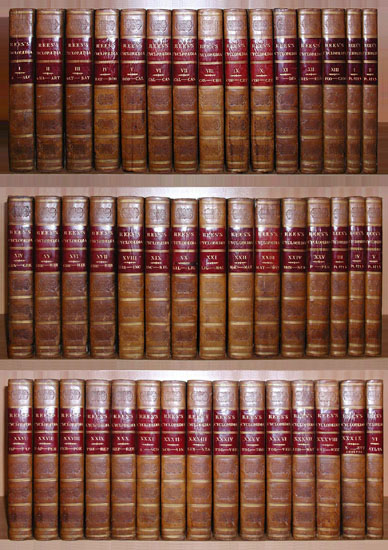
 Abraham Rees, ed., 1819, The Cyclopædia: Or, Universal Dictionary of Arts, Sciences, and Literature, Volume 31, Longman, Hurst, Rees, Orme & Brown
Abraham Rees, ed., 1819, The Cyclopædia: Or, Universal Dictionary of Arts, Sciences, and Literature, Volume 31, Longman, Hurst, Rees, Orme & Brown 